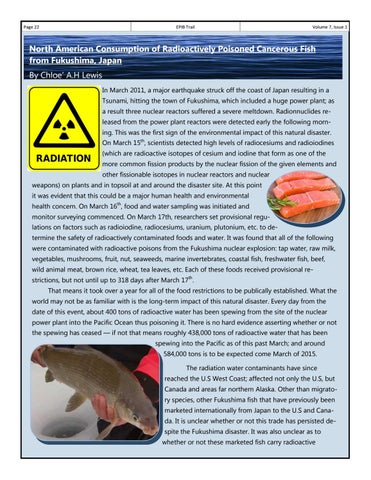Page 22
EPIB Trail
Volume 7, Issue 1
North American Consumption of Radioactively Poisoned Cancerous Fish from Fukushima, Japan By Chloe’ A.H Lewis In March 2011, a major earthquake struck off the coast of Japan resulting in a Tsunami, hitting the town of Fukushima, which included a huge power plant; as a result three nuclear reactors suffered a severe meltdown. Radionnuclides released from the power plant reactors were detected early the following morning. This was the first sign of the environmental impact of this natural disaster. On March 15th, scientists detected high levels of radiocesiums and radioiodines (which are radioactive isotopes of cesium and iodine that form as one of the more common fission products by the nuclear fission of the given elements and other fissionable isotopes in nuclear reactors and nuclear weapons) on plants and in topsoil at and around the disaster site. At this point it was evident that this could be a major human health and environmental health concern. On March 16th, food and water sampling was initiated and monitor surveying commenced. On March 17th, researchers set provisional regulations on factors such as radioiodine, radiocesiums, uranium, plutonium, etc. to determine the safety of radioactively contaminated foods and water. It was found that all of the following were contaminated with radioactive poisons from the Fukushima nuclear explosion: tap water, raw milk, vegetables, mushrooms, fruit, nut, seaweeds, marine invertebrates, coastal fish, freshwater fish, beef, wild animal meat, brown rice, wheat, tea leaves, etc. Each of these foods received provisional restrictions, but not until up to 318 days after March 17th. That means it took over a year for all of the food restrictions to be publically established. What the world may not be as familiar with is the long-term impact of this natural disaster. Every day from the date of this event, about 400 tons of radioactive water has been spewing from the site of the nuclear power plant into the Pacific Ocean thus poisoning it. There is no hard evidence asserting whether or not the spewing has ceased — if not that means roughly 438,000 tons of radioactive water that has been spewing into the Pacific as of this past March; and around 584,000 tons is to be expected come March of 2015. The radiation water contaminants have since reached the U.S West Coast; affected not only the U.S, but Canada and areas far northern Alaska. Other than migratory species, other Fukushima fish that have previously been marketed internationally from Japan to the U.S and Canada. It is unclear whether or not this trade has persisted despite the Fukushima disaster. It was also unclear as to whether or not these marketed fish carry radioactive
Back to Index

















